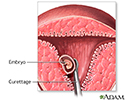Abortion - procedure
Suction curettage; Surgical abortion; Elective abortion - surgical; Therapeutic abortion - surgical
An abortion is a medical procedure that ends an undesired pregnancy by removing the fetus and placenta from the woman's uterus (womb). A medication abortion uses medicine to end an undesired pregnancy.
An abortion is not the same as miscarriage. Miscarriage is when a pregnancy ends on its own before the 20th week of pregnancy.
Description
An abortion procedure involves dilating the opening to the uterus (cervix) and placing a small suction tube into the uterus. Suction is used to remove the fetus and related pregnancy material from the uterus.
Before the procedure, you may have the following tests:
- Pelvic exam to confirm the pregnancy and estimate how many weeks pregnant you are.
- A urine or blood HCG test to confirm you are pregnant.
- A blood test to check your blood type. Based on the test result, you may need a special shot to prevent problems if you get pregnant in the future. The shot is called Rho(D) immune globulin (RhoGAM and other brands).
- An ultrasound test to check how many weeks pregnant you are and the location of the fetus in the uterus.
During the procedure:
- You will lie on an exam table.
- You may receive medicine (sedative) to help you relax and feel sleepy.
- Your feet will rest in supports called stirrups. These allow your legs to be positioned so that your health care provider can view your vagina and cervix.
- Your provider may numb your cervix so you feel little pain during the procedure.
- Small rods called dilators will be put in your cervix to gently stretch it open. Sometimes laminaria (sticks of seaweed for medical use) are placed in the cervix. This is done the day before the procedure to help the cervix dilate slowly.
- Your provider will insert a tube into your uterus, then use a special vacuum to remove the pregnancy tissue through the tube.
- You may be given an antibiotic to reduce the risk of infection.
After the procedure, you may be given medicine to help your uterus contract. This reduces bleeding.
Why the Procedure Is Performed
Reasons an abortion might be considered include:
- You have made a personal decision to not carry the pregnancy.
- The fetus has a severe birth defect or genetic problem.
- Your pregnancy may be harmful to your health.
- The pregnancy resulted after a traumatic event such as rape or incest.
The decision to end a pregnancy is very personal. To help you weigh your choices, discuss your feelings with a counselor or your provider. A family member or friend can also be of help.
Risks
An abortion procedure is very safe. It is very rare to have any complications.
Rare risks of an abortion include:
- Damage to the uterus or cervix
- Uterine perforation (accidentally putting a hole in the uterus with one of the instruments used)
- Excessive bleeding
- Infection of the uterus or fallopian tubes
- Scarring of the inside of the uterus
- Reaction to the medicines or anesthesia, such as problems breathing
- Not removing all of the tissue, requiring another procedure
After the Procedure
You will stay in a recovery area for a few hours. Your providers will tell you when you can go home. Because you may still be drowsy from the medicines, arrange ahead of time to have someone pick you up.
Follow instructions for how to care for yourself at home. Make any follow-up appointments.
Outlook (Prognosis)
Problems rarely occur after this procedure.
Physical recovery usually occurs within a few days, depending on the stage of the pregnancy. Vaginal bleeding can last for a week to 10 days. Cramping most often lasts for a day or two.
You can get pregnant before your next period, which will occur 4 to 6 weeks after the procedure. Be sure to make arrangements to prevent pregnancy, especially during the first month after the procedure. You may want to talk with your provider about emergency contraception.
References
American College of Obstetricians and Gynecologists website. ACOG Guide to Language and Abortion. www.acog.org/contact/media-center/abortion-language-guide. Updated September 2023. Accessed April 2, 2024.
Gilner JB, Rhee EHJ, Padro A, Kuller JA. Reproductive genetics. In: Gershenson DM, Lentz GM, Valea FA, Lobo RA, eds. Comprehensive Gynecology. 8th ed. Philadelphia, PA: Elsevier; 2022:chap 2.
Leeman L, Godfrey E. Pregnancy termination: first-trimester suction aspiration. In: Fowler GC, ed. Pfenninger and Fowler's Procedures for Primary Care. 4th ed. Philadelphia, PA: Elsevier; 2020:chap 113.
Rivlin K, Davis AR. Contraception and abortion. In: Gershenson DM, Lentz GM, Valea FA, Lobo RA, eds. Comprehensive Gynecology. 8th ed. Philadelphia, PA: Elsevier; 2022:chap 13.
Simpson JD, Brown A. Abortion. In: Layden EA, Thomson A, Owen P, Madhra M, Magowan BA, eds. Clinical Obstetrics and Gynaecology. 5th ed. Philadelphia, PA: Elsevier; 2023:chap 20.
Review Date: 11/10/2022
Reviewed By: John D. Jacobson, MD, Department of Obstetrics and Gynecology, Loma Linda University School of Medicine, Loma Linda, CA. Also reviewed by David C. Dugdale, MD, Medical Director, Brenda Conaway, Editorial Director, and the A.D.A.M. Editorial team. Editorial update 04/05/2024.






